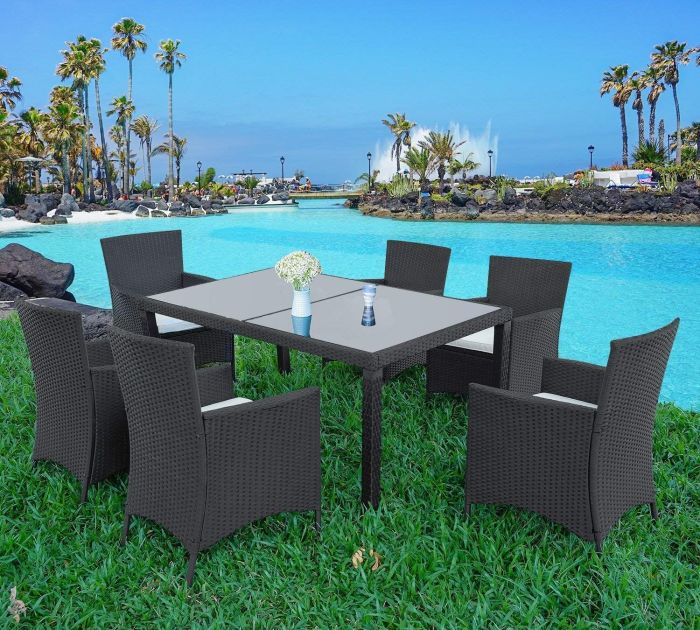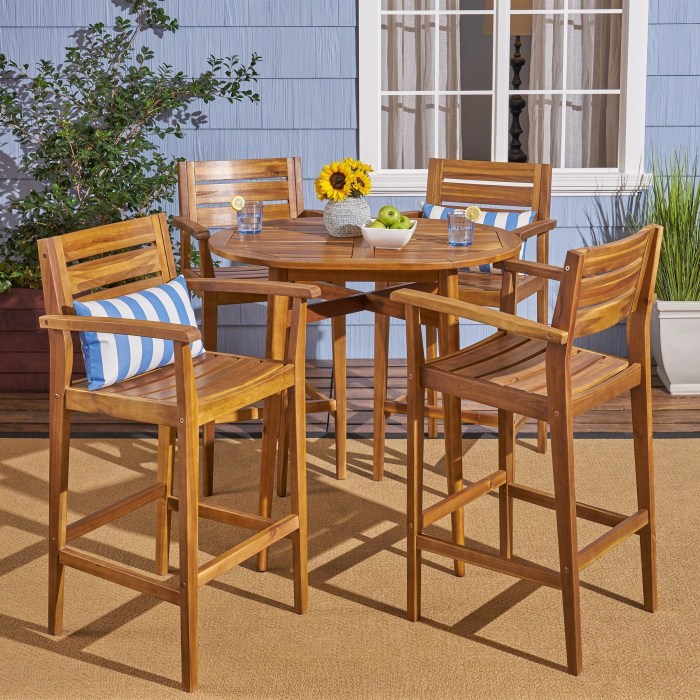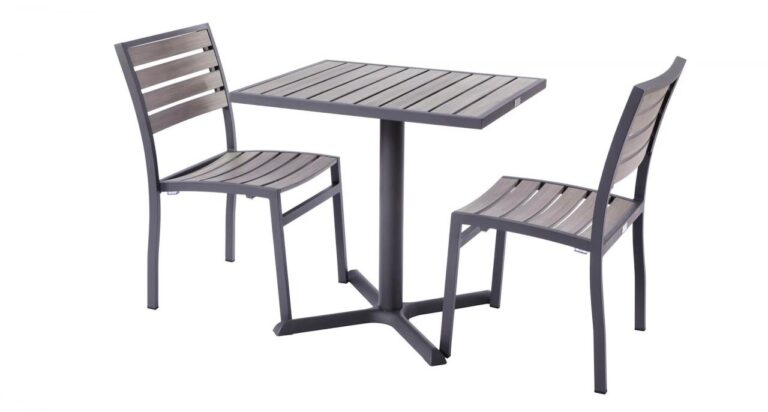Commercial Outdoor Dining Sets A Comprehensive Guide
Commercial outdoor dining sets are becoming increasingly important for various businesses, from restaurants and cafes to bars and patios. This guide provides a thorough overview of the market, exploring key design considerations, materials, and applications for these versatile spaces. Understanding the diverse needs of different commercial settings is crucial when selecting the right outdoor dining sets.
This guide delves into the key factors driving demand for commercial outdoor dining sets, examining the different materials commonly used and their respective benefits. We will explore a range of design elements and seating arrangements suitable for various commercial spaces. A detailed analysis of the importance of weather resistance and table size considerations will be presented, ensuring the sets are not only attractive but also durable and practical.
Introduction to Outdoor Dining Sets
Commercial outdoor dining sets are experiencing significant growth in various sectors, from restaurants and cafes to bars and hotels. This rising demand is driven by a multitude of factors, including the desire for outdoor dining spaces, a growing focus on customer experience, and the need for durable and aesthetically pleasing furniture. The market is diverse, encompassing a wide array of materials, styles, and designs, catering to different budgets and preferences.
Market Overview
The commercial outdoor dining set market is a substantial sector within the broader hospitality industry. This market is characterized by the need for durable, weather-resistant furniture capable of withstanding frequent use and varying weather conditions. Demand is fuelled by the growing trend of outdoor dining, allowing establishments to expand their seating capacity and attract customers. Factors such as increasing consumer preference for al fresco dining, coupled with favorable weather conditions in many regions, contribute to the growth of this market.
Material Types
A variety of materials are employed in the construction of commercial outdoor dining sets. These materials are selected based on their durability, aesthetic appeal, and cost-effectiveness. The most prevalent options include wood, metal, and plastic.
Material Comparison
| Material | Durability | Maintenance | Cost |
|---|---|---|---|
| Wood | Generally durable when properly treated and maintained. Exhibits natural beauty and aesthetic appeal. | Requires regular sealing and refinishing to prevent decay and weathering. May require specific cleaning procedures depending on the finish. | Can vary significantly depending on the type of wood and finish. Generally, higher-end wood options tend to be more expensive. |
| Metal | Highly durable, resistant to weathering, and can withstand heavy use. Metals like stainless steel and aluminum are particularly resistant to rust and corrosion. | Requires occasional cleaning and light maintenance. Some metal finishes may require specialized cleaning solutions. | Cost is generally moderate, with higher-end metal options like stainless steel being more expensive. |
| Plastic | Relatively durable, weather-resistant, and often lightweight. Modern plastic materials have improved resistance to fading and damage. | Easy to clean and maintain. Requires minimal maintenance. | Generally the most affordable option among the three. Some high-end plastic materials can approach the cost of metal or wood. |
Styles and Designs
Commercial outdoor dining sets come in a variety of styles and designs, catering to diverse aesthetics. Examples include contemporary, traditional, rustic, and modern designs. The selection is often tailored to the specific ambiance and branding of the establishment. For instance, a cafe might choose a modern, minimalist design, while a more upscale restaurant might opt for a sophisticated, traditional style. Considerations for design choices include color palettes, table shapes (round, rectangular, square), chair styles (armchair, bistro), and overall aesthetic appeal.
Design and Functionality Considerations
Commercial outdoor dining sets require careful consideration of both aesthetic appeal and practical functionality to ensure durability and longevity. Proper design and thoughtful functionality are crucial for creating inviting and successful outdoor spaces for restaurants, cafes, bars, and other businesses. Robust construction and weather-resistant materials are essential for withstanding the elements and maintaining a presentable appearance over time.
Choosing the right design and functionality for a commercial outdoor dining set involves careful planning, understanding the specific needs of the space, and considering the overall ambiance you want to create. Ultimately, this translates to increased customer satisfaction and positive brand perception.
Essential Design Elements for Durability and Attractiveness
Durable materials are paramount for commercial outdoor dining sets. High-quality, weather-resistant fabrics, robust metal frames, and strong, treated wood are key components for longevity. The choice of materials will depend on the specific climate and anticipated usage. Consider using powder-coated metals for corrosion resistance and UV-resistant fabrics to prevent fading. Properly designed joints and connections in the frame ensure stability and strength, which are crucial to the longevity of the set. Aesthetically pleasing design elements, such as visually appealing patterns and colors, are important for creating a welcoming and inviting atmosphere.
Seating Arrangements for Various Commercial Spaces
Different commercial spaces require distinct seating arrangements. For example, a bustling restaurant patio might benefit from a configuration that maximizes seating capacity and allows for efficient service. A more intimate cafe setting might be better suited to a smaller table arrangement that promotes conversation and a relaxed atmosphere. Consider the flow of traffic and the need for easy access and maneuverability for staff and customers.
Weather Resistance in Commercial Outdoor Dining Sets
Weather resistance is a critical factor in selecting commercial outdoor dining sets. Outdoor furniture must withstand harsh weather conditions like rain, snow, wind, and temperature fluctuations. Materials must be treated or constructed to resist these elements, which directly affects the longevity of the set. The selection of appropriate materials, such as weather-resistant fabrics and UV-treated wood, is paramount. Proper maintenance, including regular cleaning and protection from harsh weather conditions, is also essential for maintaining the appearance and functionality of the set over time.
Table Sizes and Shapes for Different Settings
Table size and shape significantly impact the functionality and atmosphere of a commercial outdoor dining area. A restaurant patio will require larger tables capable of accommodating larger groups of patrons, while a smaller cafe patio might benefit from smaller tables that promote a more intimate atmosphere. Table shapes should also complement the space and the overall design aesthetic. Round tables are generally good for promoting conversation and interaction, while rectangular tables provide more space for individual dining and service efficiency.
Table Size Recommendations for Various Spaces
| Space Type | Capacity | Table Size Recommendation | Table Shape Recommendation |
|---|---|---|---|
| Small Patio | 4-6 people | 4-6 seater table | Round or rectangular |
| Restaurant Patio | 20-50 people | 6-10 seater table (consider modularity) | Rectangular or communal, modular tables |
Commercial Applications: Commercial Outdoor Dining Sets
Outdoor dining sets are increasingly popular for a variety of commercial spaces. Their versatility extends beyond residential use, catering to diverse needs and preferences within the hospitality industry. This section delves into the specific applications and considerations for commercial settings, particularly restaurants, cafes, and bars.
Outdoor dining sets enhance the customer experience in commercial spaces by providing an inviting and enjoyable atmosphere. They can significantly boost revenue and brand image by attracting more customers and creating a memorable experience.
Restaurant Outdoor Dining
Restaurants often utilize expansive outdoor dining areas to accommodate larger groups and capitalize on pleasant weather. These spaces require durable, weather-resistant dining sets that can withstand the elements and maintain aesthetic appeal. The choice of material and design should complement the restaurant’s overall ambiance and brand identity. For example, a fine-dining establishment might opt for a sophisticated, high-quality set, while a casual eatery might prioritize practicality and affordability. Restaurant dining sets must be easy to clean and maintain to ensure hygiene and operational efficiency.
Cafe Outdoor Dining
Cafes, known for their casual atmosphere and quick service, benefit from outdoor seating arrangements that are easily accessible and well-suited for quick meals and relaxed social interactions. Outdoor cafe dining sets need to be lightweight, compact, and easily movable to accommodate fluctuating customer traffic. The design should prioritize comfort and accessibility for customers. Considerations include the need for quick setup and takedown, weather resistance, and easy cleaning to meet cafe operational demands. For instance, foldable tables and chairs made from weather-resistant materials are ideal for cafe environments.
Bar Outdoor Dining, Commercial outdoor dining sets
Bars often use outdoor spaces for extended service hours and social gatherings. The design of outdoor dining sets in a bar setting needs to reflect the bar’s atmosphere. They might feature a mix of seating options, including high-tops and comfortable armchairs, to cater to different customer preferences. The choice of material and design should complement the bar’s ambiance, whether it’s trendy, classic, or rustic. Outdoor dining sets for bars must be durable enough to withstand high-traffic environments and withstand the wear and tear of frequent use. Furthermore, the materials should be easily cleaned and maintained to ensure hygiene standards are met.
Comparison of Outdoor Dining Sets for Hospitality Businesses
| Business Type | Dining Set Needs | Key Considerations |
|---|---|---|
| Restaurant | Spacious designs, durable materials (e.g., aluminum, teak), ample seating for groups, easy-to-clean surfaces. | Weather resistance, aesthetic appeal that complements the restaurant’s style, easy maintenance, and durability to withstand high usage. |
| Cafe | Compact, lightweight designs, easily foldable/stackable, quick setup and takedown, comfortable seating for individual or small group use, lightweight and easy-to-move furniture. | Weather resistance, quick cleaning and sanitation, cost-effectiveness, easy maneuverability, and portability for efficient space management. |
| Bar | Mix of seating options (high-tops, armchairs), durable materials (e.g., metal, treated wood), sturdy construction, adaptable design for different customer needs, and a style that complements the bar’s ambiance. | Weather resistance, high-traffic durability, easy cleaning and maintenance, and design that complements the bar’s theme. |
Maintenance and Durability

Source: shortpixel.ai
Proper maintenance is crucial for extending the lifespan and preserving the aesthetic appeal of commercial outdoor dining sets. Consistent care and attention to detail can significantly reduce the need for costly repairs or replacements, ensuring a high return on investment. This section explores the essential maintenance procedures for various materials, emphasizing the importance of regular inspections and cleaning for long-term durability.
The longevity of outdoor dining sets depends heavily on the materials used and the level of care provided. Factors like weather exposure, frequency of use, and the chosen cleaning methods all contribute to the overall durability and aesthetic appeal. Effective maintenance strategies, detailed below, are key to preserving the value and usability of these sets for years to come.
Wood Dining Sets Maintenance
Wood is a popular choice for outdoor furniture, offering a natural aesthetic. However, it requires careful maintenance to prevent damage from moisture, UV exposure, and insects. Regular cleaning and sealing are crucial to maintain its beauty and structural integrity. Wood should be cleaned with mild soap and water, and then thoroughly dried. Applying a quality wood sealant or varnish on a regular basis protects the wood from the elements and prevents moisture absorption. This is especially critical in humid climates. For example, pressure-treated lumber is often used for outdoor structures due to its resistance to rot and decay.
Metal Dining Sets Maintenance
Metal, often used in outdoor dining sets for its durability, requires specific cleaning and maintenance procedures. Different metals, such as stainless steel, aluminum, or wrought iron, react differently to environmental factors. Regular cleaning with mild dish soap and water, followed by a thorough drying, is essential. For stainless steel, a gentle abrasive cleaner can be used to remove stubborn stains. Avoiding harsh chemicals is crucial to prevent damage to the metal’s finish. Wrought iron might require periodic oiling or a specialized rust preventative to maintain its appearance. Regular inspections for rust or corrosion are critical for preventing more extensive damage.
Fabric Dining Sets Maintenance
Outdoor fabrics, commonly used for cushions and umbrellas, are susceptible to fading, mildew, and staining. Regular cleaning is vital to maintain their color and prevent the growth of mildew. Mild detergent and water are typically sufficient for cleaning, but always check the manufacturer’s instructions for specific recommendations. Using a water repellent spray or treatment can further enhance the fabric’s durability and protect it from water damage. Protecting from prolonged sun exposure is also recommended to prevent fading.
General Maintenance Schedule
| Material | Cleaning Frequency | Inspection Frequency | Specific Maintenance Steps |
|---|---|---|---|
| Wood | Monthly (during peak season), Bi-monthly (off-season) | Quarterly | Clean with mild soap and water, dry thoroughly, apply wood sealant/varnish as needed |
| Metal (Stainless Steel) | Weekly (during peak use), Bi-weekly (off-season) | Monthly | Clean with mild soap and water, dry thoroughly. Use a gentle abrasive cleaner for stubborn stains. Inspect for rust or corrosion. |
| Metal (Wrought Iron) | Bi-weekly (during peak use), Monthly (off-season) | Bi-monthly | Clean with mild soap and water, dry thoroughly. Apply a rust preventative oil or spray. Inspect for rust or corrosion. |
| Fabric | Weekly (during peak use), Bi-weekly (off-season) | Bi-monthly | Spot clean with mild detergent and water, check for mildew or stains. Use water repellent spray as needed. |
Market Trends and Future Outlook

Source: ostkcdn.com
The commercial outdoor dining set market is experiencing a dynamic evolution, driven by shifting consumer preferences and technological advancements. Businesses are increasingly seeking durable, aesthetically pleasing, and functional solutions for their outdoor spaces. This section examines current trends, emerging materials and designs, innovative approaches, and potential future developments within the industry.
Current Market Trends
The market is gravitating towards durable, weather-resistant materials, coupled with modern design aesthetics. Sustainability is also a growing concern, with businesses seeking eco-friendly options. The trend is toward modular and adaptable designs to cater to various space configurations and event needs.
Emerging Materials and Designs
The use of high-performance composites like recycled plastics and engineered wood is gaining popularity. These materials offer attractive aesthetics, strength, and low maintenance. Modern designs emphasize clean lines, minimalist forms, and sophisticated color palettes. The use of sustainable and reclaimed materials is increasing, reflecting a growing environmental awareness. For example, recycled aluminum frames with teak or composite tops are gaining popularity, offering a blend of sustainability and visual appeal.
Innovative Approaches to Outdoor Dining Sets
Innovative companies are exploring modular designs that allow for easy configuration and customization. These sets can adapt to different event sizes and needs, from small gatherings to large corporate functions. Integrated features like built-in charging stations or lighting systems are becoming more prevalent, adding convenience and sophistication to the dining experience.
Potential Future Developments
The integration of smart technology into outdoor dining sets is a potential future development. Imagine sets equipped with sensors for real-time temperature and humidity control, or systems that automatically adjust furniture based on weather conditions. Additionally, the use of 3D printing for customized components and designs could revolutionize the industry, allowing for unique and bespoke solutions for specific spaces and needs.
Emerging Technologies Influencing the Market
Advancements in 3D printing technology are enabling the creation of complex and customized furniture pieces. This allows for greater flexibility in design and the creation of bespoke solutions tailored to specific client needs. Additionally, the use of recycled and sustainable materials, like bamboo and reclaimed wood, is increasing due to growing consumer awareness of environmental concerns. The development of smart materials that automatically adjust to environmental factors, such as temperature and humidity, is also emerging as a significant technology. For instance, sets with integrated sensors and actuators could automatically adjust table heights or shading systems in response to weather changes.
Closing Summary
In conclusion, choosing the perfect commercial outdoor dining set involves careful consideration of various factors, including material durability, maintenance requirements, and the specific needs of the intended space. From restaurants to cafes and bars, the right selection will contribute to a positive customer experience and enhance the overall ambiance. This guide has provided a comprehensive overview, empowering readers to make informed decisions when selecting outdoor dining sets for their businesses. By considering the interplay between design, functionality, and maintenance, businesses can maximize the return on investment and create a successful outdoor dining environment.





